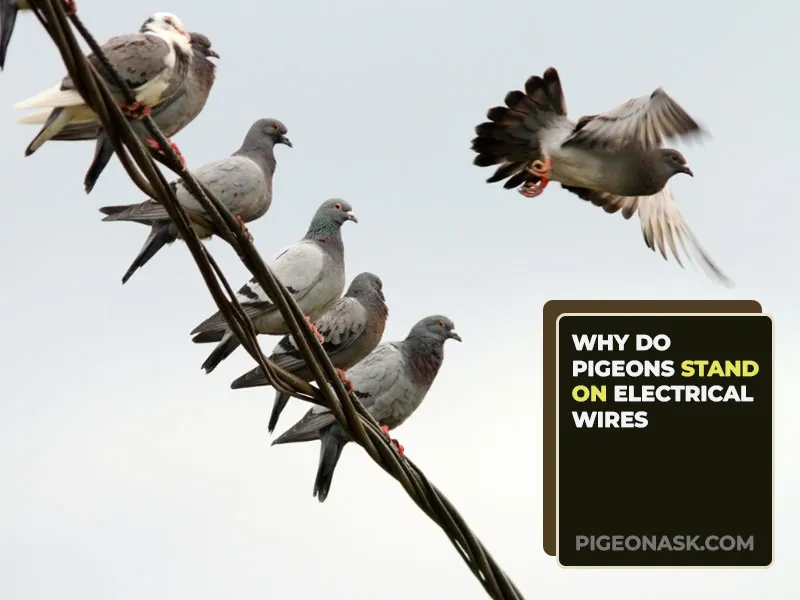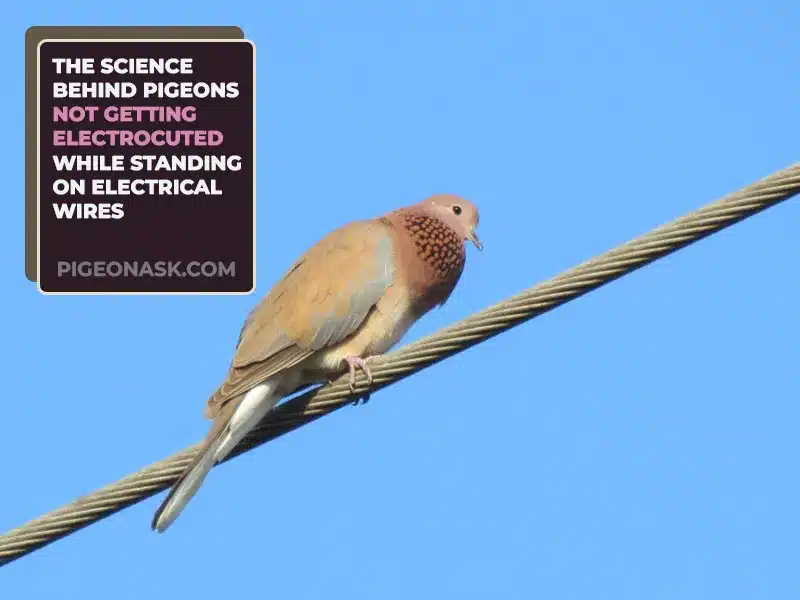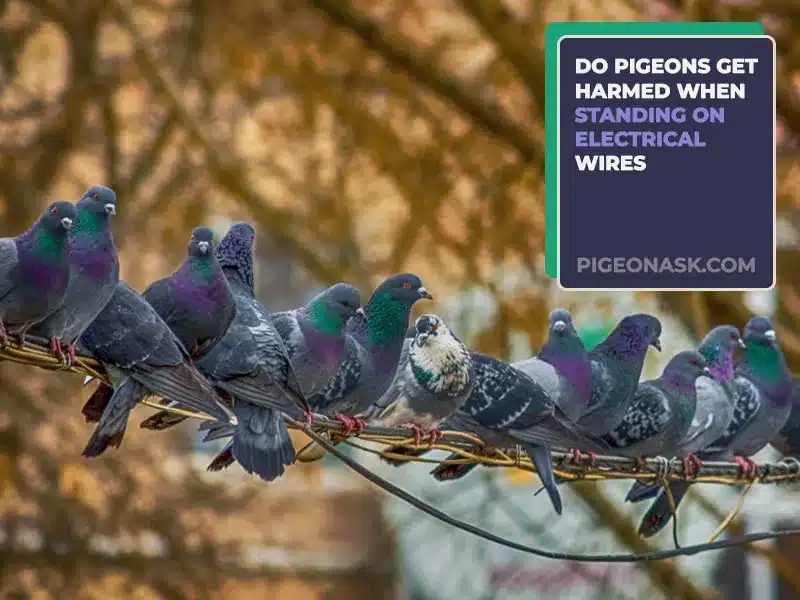Why Can Pigeons Stand on Electrical Wires?
Pigeons are agile creatures and possess a unique habit of standing on electrical wires.
If you ever encountered a flock of pigeons perched on the tallest wires in your area, you must have wondered why can pigeons stand on electrical wires? Pigeons can stand on electrical wires because they have a naturally insulating body, and they position their paws on the wire in a way that is safe and protected from electrical hazards.
It is fascinating how these elegant creatures fly so close to hazardous electrical wires, let alone perch on them for hours to scan for food.
In this article, I will take you on a journey of why pigeons stand on electrical wires and debunk the scientific reasoning behind why they do not get short-circuited so often.
Read more about pigeon habits:
Why Do Pigeons Stand on Electrical Wires
Pigeons often congregate on electrical wires for several reasons. Sometimes, it’s the height, because it gives them a really good view of the city. At times it is to be safe from predators, or meet during annual migration.

The following section explores some of the likely motivations behind this phenomenon.
01. To Search for Food
Wild pigeons have great eyes for locating their food source. They often have the habit of foraging for food that is suitable in terms of nutrition and the safety of procuring.
Electrical wires are located at very high altitudes, making them a good vantage point to scan nearby areas for food. Pigeons can cover large areas of land and easily pinpoint the areas to forage from such heights.
02. To Be Safe from Land Predators
The natural defense mechanism of pigeons to be safe from predators is their ability to fly away at high speeds.
The height of the electrical wires gives pigeons an advantage against their land predator and protects them from being preyed on by animals such as opossums and raccoons.
03. For the Warmth During Cold Weather
Electrical wires are warmer compared to the surroundings, especially when the electricity demand of an area is high. This is due to the resistance in the wires, which builds up heat energy when current passes through.
Pigeons enjoy the warmth of the electrical wires when the weather is chilly. They can keep their feet warm by perching on the warm wires of the electrical lines.
04. To Meet With Other Pigeons During Migration
There are many pigeons that migrate during winter! Pigeons will travel miles after miles in flocks to get away from extreme weather conditions.
Whenever pigeons migrate, they have to rendezvous with their flock at a favorable spot. Electrical wires extend for kilometers in length and hence provide a suitable meeting point for pigeons before they migrate.
We have covered an in-depth article on “Pigeon Habits“; if interested, you can check this article here.
The Science Behind Pigeons Not Getting Electrocuted While Standing on Electrical Wires
If you are wondering why pigeons do not get electrocuted while standing on electrical wires, then you should delve deeper into the science of current, electricity, and resistance.

Discover the reasons why pigeons sitting atop electrical wires are safe in the following section.
01. Pigeons Have Natural Insulation from Electricity
Pigeons are composed of material that provides natural insulation from electricity.
The flesh, skin, feathers, and blood that make up the different structures of a pigeon carcass are all insulators.
Insulators are objects or substances that do not allow electrons to pass through. For current to flow through an object, there needs to be free passage of electrons.
Since pigeon bodies do not allow electrons to move through freely, they naturally block the current flow and stop electrocution.
02. Pigeon Bodies Have Higher Resistance Than Wire
Electrons have a special technique to choose their path through surfaces. Electrons will decide to pass through the path, which is the easiest.
What this means is that if there are two pathways through which current can pass, it will choose the path with the lower resistance.
Resistance is a special property of any object that resists the flow of electrons. The higher the resistance, the less the electrons flow through that object.
Pigeon bodies, compared to the traditional copper wire used on electrical lines, have higher resistance.
Hence, when faced with the dilemma of which one to choose, the pigeon’s body or the copper wire, the electrical current will always choose the low-resistance copper wire.
03. Electrical Wires Are Insulated With Plastic
Electricity is very dangerous if the correct safety precautions are not used! Therefore, when making electric wires, producers properly insulate the copper wires with plastic materials.
All electrical wires are insulated in some way, at times, they are also double insulated for extra safety. This means that even if pigeons or any other animal or bird come in contact with the wires, they will not get electrocuted.
This is particularly true for the case of electrical wires that are installed in the grid lines that connect entire cities with electricity.
It is not only difficult to change the wires on electric poles, but it also causes immense disturbance in the daily life of people.
Thus, electrical wires have strong insulation and protection to be safe from any form of wear and tear due to external circumstances.
04. Pigeons Position Both Their Feet on One Wire
The most interesting feature of current is the need for a complete circuit to flow. Electrical wires are already designed in a manner that completes a circuit from the power plant to the households.
When two damaged wires are connected through a conducting surface, it causes a phenomenon known as a short circuit. This is only possible when a circuit is completed between the two wires.
When pigeons stand on electrical wires, they almost always put both their feet on one wire.
This means that they neither complete nor connect a circuit between two damaged wires, protecting them from the hazards of short circuits.
Do Pigeons Get Harmed When Standing on Electrical Wires?
Pigeons very rarely get harmed when standing on electrical wires. This can happen if the electrical wires are damaged or broken in any way.
Whenever a live wire, which is a current-carrying wire, has an alternative way to pass through rather than the resistive copper wire, it will cause either a short circuit or electrocute the new source.

If the electrical wires get damaged due to incessant weather and are still live and carrying current, then a pigeon may get electrocuted if it places one of its paws on the live end of the wire.
However, being small and agile, pigeons cannot damage the wires while standing on them. Their beak is not sharp and strong enough to cut strong and sturdy electrical wires, which are more often than not double insulated for protection.
Nevertheless, if a big pigeon attacks a wire which has already suffered major wear and tear, it will get electrocuted as soon as the beak touches the wire. But this is rarely the case.
Final Words
Pigeons are smart creatures with many habits that have influenced the adaptive waves in the bird species. One of the most noticeable acts of such kind is standing on electrical wires.
Pigeons stand on wires for a number of reasons, but what is fascinating is that they never get electrocuted.
The scientific explanation for ‘why can pigeons stand on electrical wires?’ is truly intriguing, and I hope you get the answer and more!
If you enjoyed the contents of this article, please share it with your friends and on your social handles. Do follow our website, Facebook, Twitter, and Pinterest for more riveting information about pigeons and their unconventional habits.
Article References
- https://www.birdspot.co.uk/bird-brain/why-dont-birds-get-electrocuted-sitting-on-power-lines
- https://sciencing.com/dont-birds-electrocuted-electric-wires-5180022.html
- https://engineering.mit.edu/engage/ask-an-engineer/how-do-birds-sit-on-high-voltage-power-lines-without-getting-electrocuted
Image Credit: Canva.com/photos
